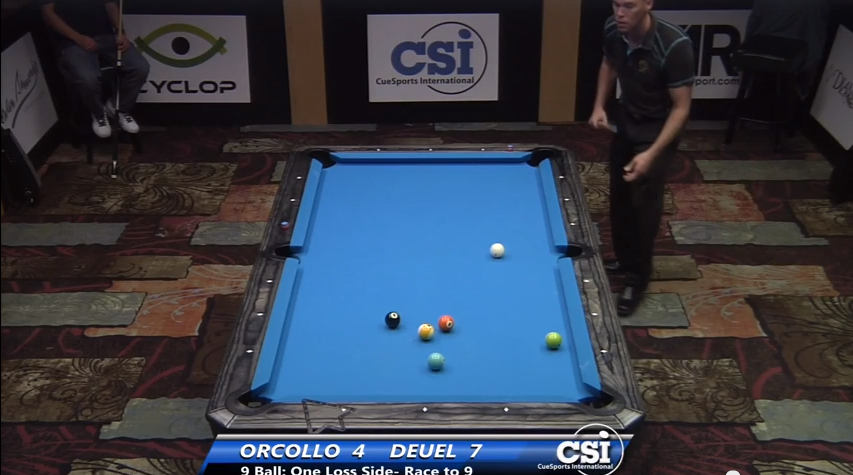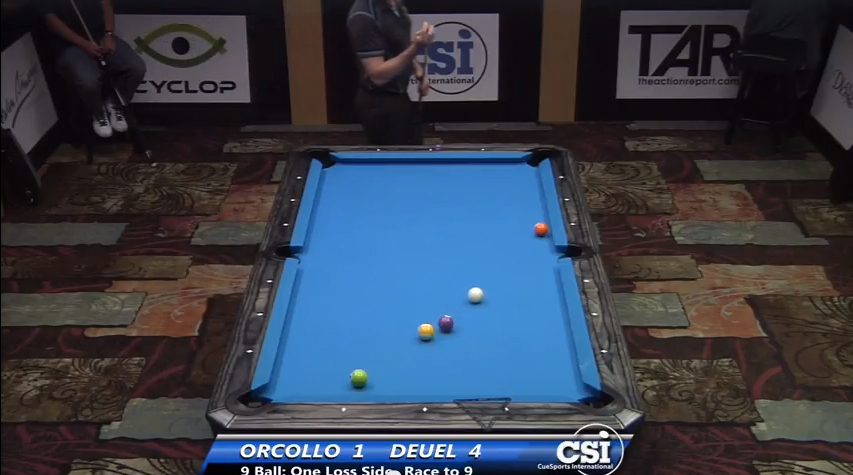Should I put balls or gaps in certain positions when I am racking for 9-ball?
No. Purposefully placing balls or gaps in certain positions in the rack is strictly illegal (see the Q&A at the bottom of this page), but the rule is not always enforced and sometimes players and referees are unknowledgeable or unaware. Also, it can be helpful to know how to read a rack based on where the balls end up when racked randomly. There are certain ball-motion patterns you can take advantage of. Some of the basics are covered in this video from Vol. V of the Video Encyclopedia of Pool Shots:
Joe Tucker’s Racking Secrets Instructional Videos also cover this topic in detail. Here’s another video (from Scott Brazier) covering the basics:
For other examples of pattern racking tricks, see the 8-ball and 9-ball break sections.
Strictly, the rules prohibit pattern racking; but if the rules under which you are playing allows it, you might want to try the soft-break pattern-racking trick Corey Deuel uses as demonstrated in the following clip from Vol. I of the Video Encyclopedia of Nine-ball and Ten-ball (VENT):
For more information, see “VENT – Part I: Corey’s 9-ball Soft Break” (BD, October, 2017).
Here are examples of Corey doing it in tournament matches:
Here’s a similar soft-break example by Ronnie Alcano, where he fairly reliably leaves a shot at the 1 in the side:
It is also illegal to intentionally place gaps between balls while racking. The following video covers this topic fairly well:
For more information, see: “How to Rack and Break 9-Ball Like a Pro” (BD, March, 2018).
Are there any pattern racking and ball-gapping tricks that work for 8-ball?
Yes. See:
from CreeDo (in AZB post):
Corey will not be satisfied until he completely breaks 9 ball.
First he figured out how to make a ball on the break every time and get a look at the 1. Then he figured out how to get an easy layout so he can run the whole rack every time. Now he’s figured out how to leave himself a wired 9 ball combo after running just 2 or 3 balls:
https://www.youtube.com/watch?v=mZa59OiRJd8
He hasn’t quite perfected it, and maybe it only works on the barbox. But in this one match he set it up every time and was able to execute it for 5 out of his 9 wins.
He apparently randomizes a few balls so as to skirt around the pattern racking rule, though it’s obvious what he’s doing. Sometimes he just has to run to the 3 ball, which is near-wired to the 9. Other times to the 4 or 5. Somehow it’s never, say, the 8 ball.
Don’t get me wrong, the match actually shows some amazing shots by Corey. It’s not like all he does is get early 9’s and then runs to the bank.
Dennis seems to be racking differently all the time and breaking much firmer. Almost like he wants a random outcome. I dunno if he’s trying to stick to the spirit of the law, or if he just gave up trying to imitate what Corey does. He’s pattern racked in the past.






Isn’t “pattern racking” and “ball gapping” prohibited by the rules?
from the WPA rules:
2.2 Nine Ball Rack
The object balls are racked as tightly as possible in a diamond shape, with the one ball at the apex of the diamond and on the foot spot and the nine ball in the middle of the diamond. The other balls will be placed in the diamond without purposeful or intentional pattern.
Obviously, a strict interpretation and strict enforcement of this rule prohibits “pattern racking,” where you place balls or gaps in certain positions for an advantage. However, the rule isn’t usually interpreted so strictly. Often (e.g., in most leagues and tournaments), the last sentence is interpreted: It doesn’t matter where the other balls are placed. Also, somebody can easily “pattern rack” or “gap the rack” without it seeming “intentional” or “purposeful.” However, a ref or opponent has the right to protest if certain “patterns” are obviously being used (e.g., always placing the 2-ball in the back of the rack).
Obviously, the best solution is to have a neutral party rack the balls (which is done in the WPBA TV events). With “rack your own” or “opponent racking,” “pattern racking” is always likely to occur unless each ball is required to be in an exact position, but this would require a rules change and would result in repetitious run-out patterns (especially with new balls on a “trained” table with consistently good racks).
One way to prevent pattern racking and possible disputes (e.g., in leagues and tournaments) is to use the “No Conflict Rules” for racking and breaking in 8 ball, 9 ball, and 10 ball.
Regardless, even if the balls are truly racked randomly, the balls will still be in a certain pattern in a given rack. And it can sometimes be useful to know where balls in certain positions tend to go.
Dr. Dave keeps this site commercial free, with no ads. If you appreciate the free resources, please consider making a one-time or monthly donation to show your support:
